The flag
The Northern Territory flag was flown for the first time at a ceremony in Darwin on 1 July 1978 marking the grant of self‑government.
It includes the 3 official Northern Territory colours, black, white and red ochre, and a stylised version of the Territory’s floral emblem, the Sturt’s desert rose.
The desert rose on the red ochre panel has 7 petals with a seven‑pointed star in the centre, symbolising the 6 Australian states and the Northern Territory.
The 5 white stars sitting on the black panel on the left of the flag represent the Southern Cross.
The colour references are:
- Red Ochre: PANTONE® 159C, and
- Black: PANTONE® Black C.
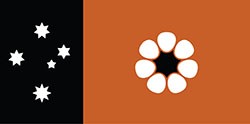
The Coat of Arms
The Coat of Arms is symbolic of the people, history and landscape of the Northern Territory. It features the floral and fauna emblems, the Sturt’s desert rose, 2 red kangaroos and a wedge‑tailed eagle.
The kangaroos hold a shield decorated by Aboriginal people’s motifs in one hand and shells found on the Northern Territory’s coastline in the other.
In the centre of the shield is an x‑ray drawing of a woman as seen in rock art in Arnhem Land. The designs on either side symbolise camp sites joined by path markings of Central Australian Aboriginal peoples.
The eagle holds an Aboriginal Tjurunga stone that rests on a helmet. The helmet is a reminder of the Northern Territory’s war history.
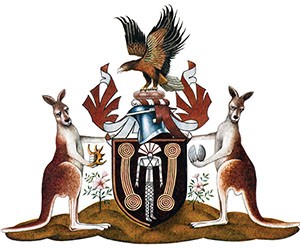
There is no Territory badge.
The floral emblem
Sturt’s desert rose
Sturt’s desert rose was first proclaimed as the territory’s floral emblem on 12 July 1961 but it wasn’t until 1974 in an Executive Statement in the Legislative Assembly of the Northern Territory that this was officially confirmed. It is an arid plant which grows best in stony or rocky ground such as dry creek beds.
The desert rose has had many botanical names in the past. It is a member of the cotton family, rather than the rose family. It was named after Charles Sturt who first collected it during his journey to Central Australia from 1844 to 1845.
The plant is found in the southern parts of the Territory, and is cultivated as a garden shrub in Alice Springs. It can also be found in parts of South Australia, New South Wales and Queensland.
It’s a small bushy plant which usually grows to 1.5 metres. It has dark green, round to oval shaped leaves. The petals of the flowers are mauve with a deep red marking at the base. The flowers look similar to the hibiscus, which belongs to the same family. The plant’s fruit is capsule‑shaped and contains small seeds covered in short hair, which is a trait of the cotton family.
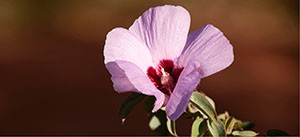
The animal emblem
The red kangaroo
The red kangaroo embodies the Northern Territory’s unique wildlife. It is the largest living marsupial with adult males standing more than 2 metres tall and weighing as much as 75 kilograms.
Males are a rusty brown colour and females a smoky grey, while both have heat‑reflecting paler fur on their under surfaces. They also have striking white marks with a black line on the sides of their muzzles.
Their long, thin limbs allow them to travel large distances through harsh conditions. They are found in the Northern Territory in very dry areas. During droughts they retreat to waterways and open grassy areas where food is available. Sometimes several hundred kangaroos can be found in the same place, although they are independent animals and have no social structure. They prefer to rest under shade during the heat of the day.
When the drought breaks, they move to mulga tree areas where food and shade is available. This is also where they breed. Females normally carry one young in their pouch.
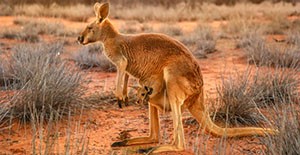
The bird emblem
The wedge‑tailed eagle
The wedge‑tailed eagle was proclaimed as one of the 2 Northern Territory faunal emblems on 19 June 1975.
The wedge‑tailed eagle is Australia’s largest bird of prey with an average wingspan of 2.5 metres. It is dark brown with a chestnut neck.
Their long, wedge‑shaped tail and broad wings make it easy to recognise. Their legs are covered in feathers right down to their feet. A hooked beak and strong talons are the hallmarks of a bird that hunts other animals.
Although they are found throughout Australia, in the Northern Territory they are more commonly found in the arid centre than on the coastal plains of the north.
Before cattle and sheep farming in Australia, they ate a range of small mammals that lived in the soft ground cover, as well as other birds and reptiles. Agriculture and fire has destroyed much of the ground cover, so introduced species like rabbits have become a large part of their diet. It is thought the eagle also hunts kangaroos that gather around watering holes.
Eagles form long-lasting pairs who defend their nesting and breeding territory against intruders. They nest in the high trees and build large platform nests that can be reused from year to year.
At sunrise they hunt for food. Later on, as the sun heats up the air close to the ground, strong updrafts allow the eagle to soar and glide up to 2,000 metres high during the middle of the day, warning other eagles to stay out of their territory.
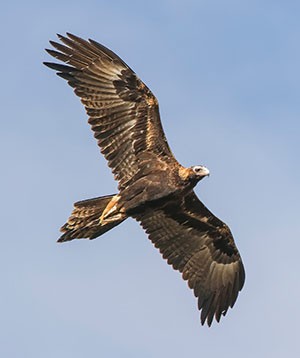
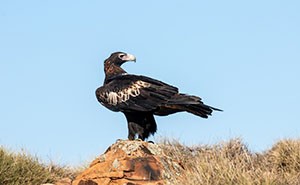
The fish emblem
The barramundi
The barramundi has been the fish emblem of the Northern Territory since 1999. The Northern Territory has the largest numbers of barramundi in Australia. It is a popular target for commercial and recreational anglers because of the quality of its flesh, its fighting ability, size and readiness to take artificial lures.
Barramundi, commonly called ‘barra’, is also fished by people for its economic, health and cultural importance. Females spawn up to 32 million eggs between September and March. Juvenile barramundi are 5 to 50 millimetres long and move into mangrove and wetland habitats during the wet season. After 3 to 5 years most of the freshwater barramundi migrate back to the ocean to spawn.
Barramundi can grow to be very large, some have been recorded at over 45 kilograms in weight and 150 centimetres long. There have been barramundi recorded at over 35 years of age, though a maximum age of 20 years is more common. Most barramundi are born as males but at about 8 years of age they turn into females. They can grow to 100 centimetres long by the time they are 8 years old. Any barramundi that is over 95 centimetres long is probably a female.
A barramundi’s diet consists of about everything that lives in or around water, including insects, spiders, crocodiles, prawns, fish and each other. The diet of a larger barramundi consists of 60 per cent fish and 40 per cent crustaceans, mostly prawns. Smaller barramundi eat mostly prawns. As water temperatures cool during the dry season, barramundi slow down and eat less frequently.
Barramundi activity increases with warmer temperatures and catch rates are generally higher. During the build‑up and wet season, water temperatures can be up to 10 degrees Celsius warmer than during the dry season. Tagging studies show recreational and commercial fishers take less than 5 per cent of the barramundi in a river system per year.
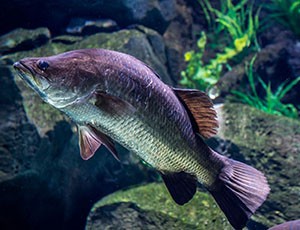
For further information on the symbols of the Northern Territory, please contact:
Department of the Chief Minister and Cabinet
Level 9
NT House, 22 Mitchell Street
Darwin NT 0800
Phone: 08 8999 6238
Email: protocol.dcm@nt.gov.au
